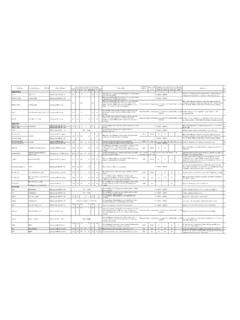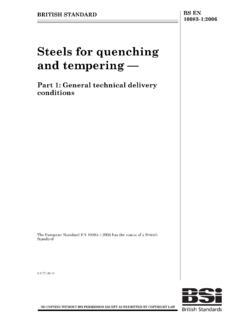Transcription of AEROSPACE MATERIAL - GoKartHead
1 SAE Technical Standards Board Rules provide that: This report is published by SAE to advance the state of technical and engineering sciences. The use of this report is entirely voluntary, and its applicability and suitability for any particular use, including any patent infringement arising therefrom, is the sole responsibility of the user. SAE reviews each technical report at least every five years at which time it may be reaffirmed, revised, or cancelled. SAE invites your written comments and suggestions. Copyright 2007 SAE International All rights reserved. No part of this publication may be reproduced, stored in a retrieval system or transmitted, in any form or by any means, electronic, mechanical, photocopying, recording, or otherwise, without the prior written permission of SAE.
2 TO PLACE A DOCUMENT ORDER: Tel: 877-606-7323 (inside USA and Canada) Tel: 724-776-4970 (outside USA) Fax: 724-776-0790 Email: SAE WEB ADDRESS: AMS 2759/1D AEROSPACE MATERIAL SPECIFICATION Issued OCT 1984 Revised JUN 2007 Superseding AMS 2759/1C Heat Treatment of Carbon and Low-Alloy Steel Parts Minimum Tensile Strength Below 220 ksi (1517 MPa) RATIONALE AMS 2759/1D results from a Five Year Review and update of this specification. 1. SCOPE This specification, in conjunction with the general requirements for steel heat treatment covered in AMS 2759, establishes the requirements for heat treatment of carbon and low-alloy steel parts to minimum ultimate tensile strengths below 220 ksi (1517 MPa).
3 Parts are defined in AMS 2759. 2. APPLICABLE DOCUMENTS The issue of the following documents in effect on the date of the purchase order forms a part of this specification to the extent specified herein. The supplier may work to a subsequent revision of a document unless a specific document issue is specified. When the referenced document has been cancelled and no superseding document has been specified, the last published issue of that document shall apply. SAE Publications Available from SAE International, 400 Commonwealth Drive, Warrendale, PA 15096-0001, Tel: 877-606-7323 (inside USA and Canada) or 724-776-4970 (outside USA), AMS 2418 Plating, Copper AMS 2424 Plating, Nickel Low-Stressed Deposit AMS 2759 Heat Treatment of Steel Parts, General Requirements ARP1820 Chord Method of Evaluating Surface Microstructural Characteristics ASTM Publications Available from ASTM International, 100 Barr Harbor Drive, Box C700, West Conshohocken, PA 19428-2959, Tel: 610-832-9585, ASTM E 384 Microindentation Hardness of Materials SAE AMS 2759/1D - 2 - 3.
4 TECHNICAL REQUIREMENTS Heat Treatment Shall conform to AMS 2759 and the requirements specified herein. Equipment Shall conform to AMS 2759. Furnace temperature uniformity requirements for annealing, subcritical annealing, normalizing, hardening, straightening, stress relieving, and baking shall be 25 F ( 14 C), and for tempering shall be 15 F ( 8 C) except shall be 10 F ( 6 C) for H-11, D6AC, and 9Ni-4Co steels. Heating Environment Parts shall be controlled by type, (See ), and heat treated in the class of atmosphere (See ) permitted in Table 1 for that type when heating above 1250 F (677 C). When heating parts at 1250 F (677 C) or below, Class A, B, or C atmosphere may be used (See ).
5 TABLE 1 - ATMOSPHERES Part Classification (1) Class A Class B Class C Type 1 Permitted Permitted Permitted Type 2 Permitted PROHIBITED (2) Permitted (3) Type 3 Permitted Permitted PROHIBITED Type 4 Permitted Permitted (3) PROHIBITED Notes: (1) See (2) Permitted provided the atmosphere is controlled to produce no carburization or nitriding asdescribed in (3) Prohibited if a specific requirement to control the surface carbon on all surfaces is specified. Types of Parts The heat treating processor shall determine the part type. Type 1: Parts with inch ( mm) or more to be machined off all surfaces after heat treatment and parts with as-forged, as-cast, or hot-finished mill surfaces at time of heat treatment with all surfaces to be machined off.
6 Unless informed that all surfaces will have at least inch ( mm) machined off, the heat treating processor shall assume all surfaces will not, and shall control the part as Type 2, 3, or 4, as applicable. Type 2: Forgings, castings, sheet, strip, plate, bar, rod, tubing, and extrusions with hot-finished surfaces at time of heat treatment and which will remain on the finished part. Type 3: Parts with finished machined surfaces or surfaces with less than inch ( mm) to be machined off any surface after heat treatment and parts with protective coating on all surfaces. Type 4: Parts that are partially machined with both unmachined, as-forged, as-cast, or hot-finished mill surfaces and finished machined surfaces or machined surfaces with less than inch ( mm) to be machined off after heat treatment.
7 If part type cannot be determined, the part shall be processed as Type 3. Classes of Atmospheres Class A: Argon, hydrogen, helium, nitrogen, nitrogen-hydrogen blends, vacuum, or neutral salt. Nitrogen from dissociated ammonia is not permitted. Class B: Endothermic, exothermic, or carbon-containing nitrogen-base (See ). Class C: Air or products of combustion. SAE AMS 2759/1D - 3 - Atmospheres Atmosphere furnaces shall be controlled to ensure that surfaces of heat treated parts are within the limits specified in Salt baths shall be tested in accordance with AMS 2759. Protective Coatings A supplemental coating or plating is permitted when approved by the cognizant engineering organization.
8 Fine grain copper plating in accordance with AMS 2418 or nickel plating in accordance with AMS 2424 may be used without approval but the surface contamination specimens in shall not be plated (See ). Procedure Preheating Preheating until furnace stabilization in the 900 to 1200 F (482 to 649 C) range is recommended before heating parts above 1300 F (704 C) if the parts have previously been heat treated to a hardness greater than 35 HRC, have abrupt changes of section thickness, have sharp reentrant angles, have finished machined surfaces, have been welded, have been cold formed or straightened, have holes, or have sharp or only slightly-rounded notches or corners. Soaking Heating shall be controlled, as described in AMS 2759, such that either the heating medium or the part temperature, as applicable, is maintained at the set temperature in Table 2, 3, or 4 for the soak time specified herein.
9 Soaking shall commence when all control, indicating, and recording thermocouples reach the specified set temperature or, if load thermocouples as defined in AMS 2759 are used, when the part temperature reaches the minimum of the furnace uniformity tolerance at the set temperature. Parts coated with copper plate or similar reflective coatings that tend to reflect radiant heat shall have their soak time increased by at least 50%, unless load thermocouples are used. Annealing Shall be accomplished by heating to the temperature specified in Table 2, soaking for the time specified in Table 5, and cooling to below the temperature specified in Table 2 at the rate shown in Table 2 followed by air cooling to ambient temperature.
10 Isothermal annealing treatments may be used provided equivalent hardness and microstructure are obtained. Isothermal annealing shall be accomplished by heating to the annealing temperature specified in Table 2, soaking for the time specified in Table 5, cooling to a temperature below the critical, holding for sufficient time to complete transformation, and air cooling to ambient temperature. Subcritical Annealing Shall be accomplished prior to hardening by heating in the range 1150 to 1250 F (621 to 677 C), soaking for the time specified in Table 5, and cooling to ambient temperature. Steel parts of the 9Ni-4Co type shall be subcritical annealed as specified in Table 2. Pre-Hardening Stress Relieving Shall be accomplished prior to hardening by heating in the range 1000 to 1250 F (538 to 677 C), soaking for not less than the time specified in Table 5, and cooling to ambient temperature.






